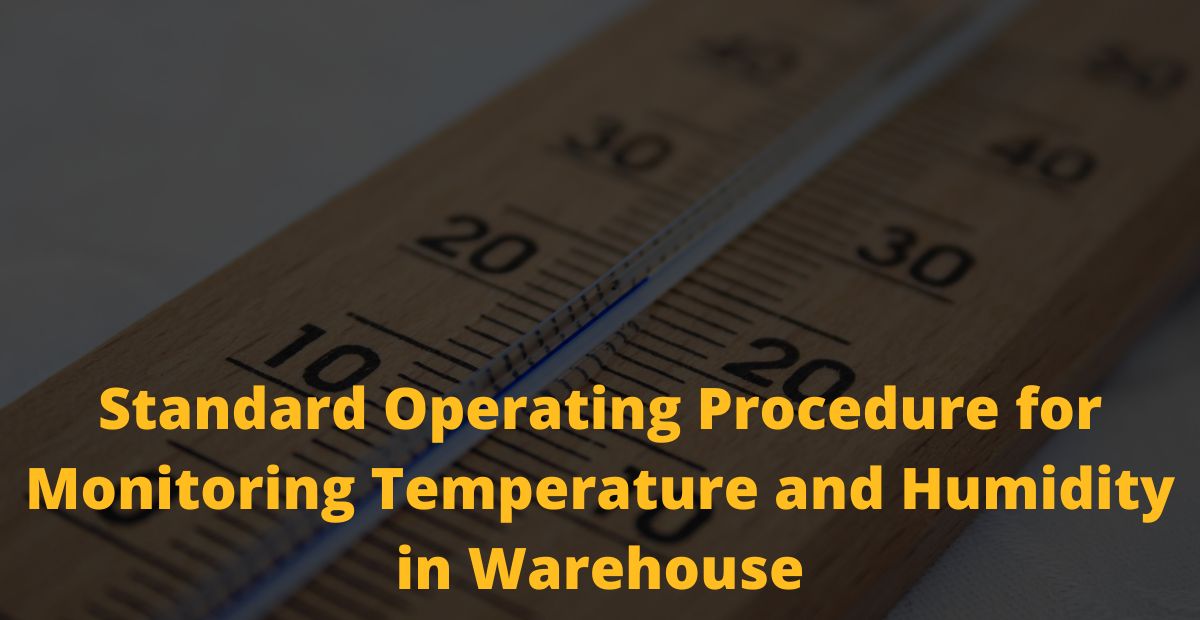
Standard Operating Procedure for Monitoring Temperature and Humidity in Warehouse
Standard Operating Procedure for Standard Operating Procedure for Monitoring Temperature and Humidity in Warehouse
1. Purpose:
To lay down a procedure for Monitoring Temperature and Humidity in Warehouse at [company name].
2. Scope
The scope of this SOP is applicable for Monitoring Temperature and Humidity in Warehouse at [company name].
3. Responsibility
Warehouse personnel: To record the temperature and relative humidity.
Engineering Personnel: Management of Building Management System (BMS), recording of alarm and rectification of temperature control system to maintain the temperature in the storage areas.
Head – warehouse: To ensure the compliance of SOP and supervision of the operation
4. Definitions
Not applicable
5. Procedure
• Temperature and Relative Humidity monitoring in the warehouse shall be done through building management system (BMS) by engineering personnel.
• In case of any execution noted which does not get rectified as per defined time period, BMS engineer shall inform to warehouse personnel so that warehouse personnel can relocate the material as per required storage condition.
• In the areas where the area monitoring is not governed through BMS, monitoring are temperature shall be done using calibrated thermo hygrometer by placing it at hot spot of the area.
• The storage area such as cooling cabinet, cold room or any similar equipment is used to store the material and it is not connected to BMS, the equipment shall be monitored using respective equipment manufacturer’s software.
• Routine monitoring of area shall be done at identified hot spot through the area mapping studies (Empty area mapping, loaded area mapping for seven day each for all the seasons as per respective country condition).
• In case any modification is done in the storage facility, area shall be remapped and monitoring of area shall be done at new hot spot.
• During periodic mapping (once in five years), if hot spot of storage area observed changed during temperature mapping study, monitoring location shall be shifted to new location within 7 days from the approval of temperature mapping study report.
• Ambient area which is not monitored or controlled through BMS also shall be mapped to identify for hot spot through seasonal mapping study. Hot point noted during temperature mapping study shall be considered for daily temperature monitoring.
• Mapping shall be done for temperature only. Relative humidity shall be recorded on daily basis at the hottest point found during temperature mapping for data collection only.
• Warehouse person shall monitor the temperature and relative humidity using thermo hygrometer where there is no automated monitoring and data logging device is available.
• While monitoring environmental condition using thermo hygrometer, daily minimum and maximum reading shall be taken at around [specify any one time] and it shall be recorded the readings in the logbook by warehouse personnel.
• Warehouse head shall review the temperature data at the end of month.
• Upper limit for the ambient storage area of warehouse shall not be more than [Specify temperature] °C. Note: This shall be decided by warehouse in-charge in coordination with engineering department and quality assurance department based on the risk assessment.
• If the temperature is recorded more than [Specify temperature] °C in ambient storage area of warehouse then deviation shall be reported.
• Whenever any thermo hygrometer is due for calibration, use another calibrated thermo hygrometer. Reset the thermo hygrometer before use and place on designated location. Handover the thermo hygrometer is due for calibration to calibration department.
• To record the temperature and relative humidity where thermo hygrometer is displayed, follow the below procedure:
• Collect the thermo hygrometer that is placed at the hot. Note: Wherever possible, take the reading at its place.
• Record the reading and reset the thermo hygrometer.
• Record the current temperature and relative humidity (Minimum and Maximum reading. After the reading is taken press the reset so that new reading can be captured once the previous reading is recorded.
• Place the thermo hygrometer back to at hot point.
6. Frequency
Daily monitoring
7. Formats
Room Temperature and Relative Humidity record
Temperature Limit:
Relative Humidity Limit:
Department:
Location:
Date
Time
Temperature (Minimum and Maximum)
Relative Humidity
Recorded By
Note: If the temperature is recorded more than specified storage condition for more than specified time, warehouse person shall report the deviation.
Remarks:
Review done By (Signature & Date)

